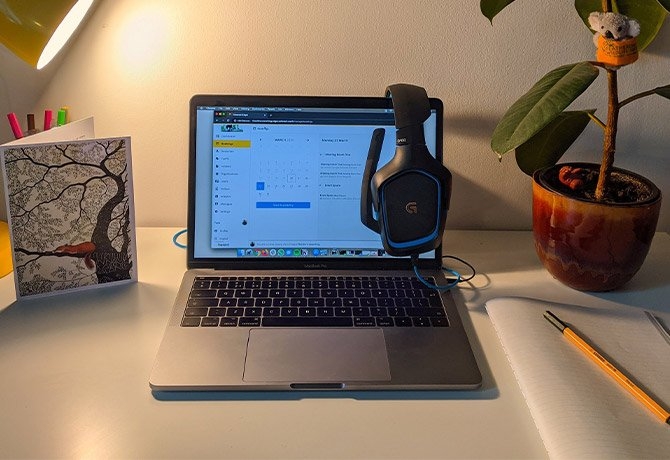When we first found out we’d have to work from home, the mandate may have come with cautious excitement or measured dread. Working from home can have a bunch of great benefits, but it comes with a lot of drawbacks, too. Many of us haven’t spent an extended time working at home like this and don’t have the domestic infrastructure to stay productive while gleaning the upsides to the novel circumstance. Hopefully, by implementing a few of the steps below, you’ll be better equipped for this brave new world we find ourselves.
1. Set Time and Space Boundaries
One of the most effective ways to help you sleep at night is to make a clear distinction between the space you sleep in and every other space. Your brain will pick up on various cues you give it when you operate in a certain space. Ever get the hankering for a snack when you walk through the kitchen even if you’re not hungry? Try implementing the same concept to a workspace at home. If it’s available to you, use one space in particular for work and only for work.
-
If you only have a part of a table, use painter’s tape to section off your workstation.
-
If you have children in the home, implement a “red light, green light” system. When your red piece of paper (or maybe an action figure with his hand raised) is up, it’s time for mom or dad to do focused work. When the green paper is up, it’s ok to engage.
-
Don’t get distracted by chores that might be immediately obvious. They can wait. If there is a chore or other idea that keeps popping into your head that’s not work-related, have a notepad to write it down so you can come back to it later.
2. Establish Work Hours and Attire
Take advantage of a less structured 8-5 or whatever the normal clock-in, clock-out hours were, while still remembering the importance of having dedicated portions of the day for focused work. Just make sure you let your fellow workers know.
-
Try frontloading activity with the family earlier in the day. A casual morning routine is key to happiness.
-
While you might save yourself from putting on your full coat and tie, the way you dress impacts how seriously you take your actions. Wearing a bathrobe or workout pants all day translates to a lazier attitude towards your tasks. If you wouldn’t go out in public looking the way you do, don’t “go” to work with the same appearance.
-
Use the free clockify app to track hours worked.
3. Make Technology Work for You
Many companies are scrambling to make a work from home situation productive. This includes implementing some new software to keep people connected. This will mean many of us must adapt. For some, it can be more difficult than others. Time spent with co-workers constitutes a significant amount of our weekly social interactions for many of us. So, why not allow a little extra time during your next video meeting to shoot the breeze? Speaking of which…
-
If you’re using video conferencing software, make sure you know how to navigate it. Don’t be like one Zoom newbie that accidentally left her camera running during a meeting while she used the restroom.
-
Instant messaging software will likely mean you’ll be getting far more little red notifications than usual. Talk to your superiors and peers about times when you need to shut those off to prevent distractions during the day. Have a place for high priority contact but typically, 99% of daily communication can wait at least a half-hour while you finish your present task.
-
Don’t think that using this software allows you to multitask. In fact, multitasking isn’t actually possible. Our brains can’t focus on two things at once. It really just describes quickly switching focus from one task to another. Each switch imposes a mental tax that saps time and attention that you could otherwise use to focus on a singular task for 20-30 minutes at a time.
Finally, cut yourself some slack if you’re finding it difficult to adapt. This isn’t normal and there’s no handbook on how to stay sane during a pandemic in the Spring of 2020. Though if there is, maybe this could offer a summary! How have you adapted? Comment down below or show us how you’re working from home (and tag us on social media!)
P.S. Spare a thought for our New York City residents who must share a 350 square foot space with very little access to wide-open space while trying to stay productive.
Marcus Farris is the Veteran Wellness Coordinator at Mission 22. He’s a Certified Health Coach and Level 1 Crossfit Trainer.

